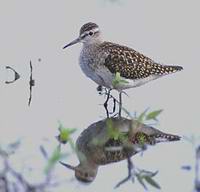The Wood Sandpiper Tringa glareola
Threating to Extinct
 The Wood Sandpiper (Tringa glareola) is a common winter visitor and one of the strongest migrants in the genus. It is typically an inland wader.
The Wood Sandpiper (Tringa glareola) is a common winter visitor and one of the strongest migrants in the genus. It is typically an inland wader.The Wood Sandpiper, Tringa glareola, is a small wader. It is the smallest of the shanks, and breeds in subarctic wetlands from the Scottish Highlands across Europe and Asia. It will nest on the ground, or reuse the old tree nest of another bird, such as the Fieldfare. It resembles a longer-legged, elegant Green, or Solitary Sandpiper with a short fine bill, brown back and longer yellowish legs. It differs from the first of those species in that the white rump patch is smaller and less contrasting, and Solitary lacks a white rump anyway. They migrate to Africa and southern Asia, particularly India. This bird is usually found on fresh water during migration and wintering. These birds forage by probing in shallow water or on wet mud. They mainly eat insects, and similar small prey.
The Wood Sandpiper in all plumages is slimmer, leggier and more elegant than most other sandpipers, more like a small Redshank. They also have beautifully spangled upperparts and an obvious pale supercilium. They are a paler brown than the Green Sandpiper and there is no obvious contrast between dark breast and pale belly. In flight Wood Sandpipers show a neat, square white rump but they look brown and white not black and white and their underwings are pale.
Identification: A slim, graceful, buffish-brown wader with a long pale supercilium, spotted upper parts, streaked breast and quite long legs. In flight white rump contrasts with brown back and wings. Most often confused with Green Sandpiper, but can be easily distinguished by longer, yellowish legs and slimmer appearance, heavily speckled upper parts, and prominent supercilium.In flight it can be identified by the call, slimmer body and narrower wings, toes projecting clearly beyond tail, paler under-wing contrasting less with white under-parts, and paler brown upper parts contrasting less with smaller white rump. Bill is shortish and straight, fairly deep at base, with a blackish distal half and an olive-green or yellow-green base, rather browner in juveniles. Iris is dark brown. Legs dull yellowish, usually greenish or brownish-yellow, always looking pale at a distance. Adult breeding has heavily streaked breast and barred flanks, and upper parts are barred and spotted with pale grey-brown and white. Adult non-breeding has more uniform grey-brown upper parts, spotted whitish, and breast is brownish and lightly streaked. Juvenile has warm brown upperts heavily speckled with warm buff, and lightly streaked buff breast.
Voice : Flight call is whistled ‘chiff-if’ or ‘chiff-if-iff’. Alarm call is a sharper ‘chip’, often repeated rapidly.
Habits: Often forages in scattered parties, and frequently occurs in flocks on migration. Feeds in shallow water and on mud by probing, picking from the surface and sweeping its bill from side to side in water. Usually towers away when flushed, giving distinctive call.
Food: Crustaceans, insects, molluses.
Habitat: In winter fond of shallow waters with emergent vegetation; marshes, village tanks, lakes, wet-paddy-fields, mudflats and tidal creeks.
Movements: Strongly migration; winters mainly in the southern part of the old world, although occasional individuals have been found as far north as Britain. Often abundant in sub-Saharan Africa and in India-sub contianent, but surprisingly scarce in Australia and only a vagrant to Tasmania. No recored yet from New Zealand. As a migrant, scarce in West Europe, particularly so in spring.
Races: No geographical variation is known.
Measurements: Length is 190-210 mm. Wing 120-134 mm; Bill 25-32 mm; tarsus 32-41mm; tail 45-53mm. Local distribution and status: Widespread common winter visitor.
Threat: Habitat loss.
Causes of Loss:
|